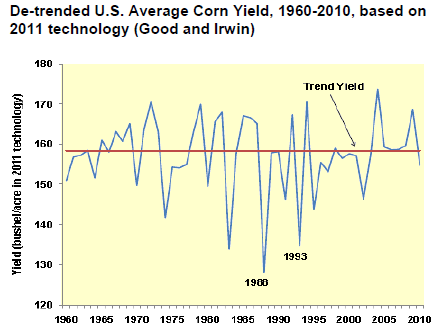



CME: Forces Shaping Corn Supply and Demand
US - The University of Illinois released last week a publication entitled Alternative 2011 Corn Production , Consumption and Price Scenarios that we believe is a good read for those trying to get a handle — or at least a starting point — in looking at what may transpire in the US corn market, write Steve Meyer and Len Steiner.The publication by Drs Darrel Good and Scott Irwin takes a look at the forces shaping both supply and demand over the coming year. Some highlights are:
- A thorough discussion of 2011 yield scenarios. The authors use a long-term yield based on data since 1960. That trend provides
an estimate of 158.4 bushels/acre for 2011. Drs Good and Irwin use 158 in their supply and demand forecasts. They point out that the
shorter-term (some back only as far as 1996) yield trends being used by some analysts result in yield estimates that are about 3
bushels/acre higher than those used in the paper. Good and Irwin argue that these more optimistic trends are not actually a new
trend but are simply due to “... adverse weather being experienced less frequently since the mid-1990s..."
- Drs Good and Irwin demonstrate yield variability and derive their “good weather” and “bad weather” yields by detrending the historical yield data so that past years, in essence, reflect 2011 technology. They accomplish this by adding the trending yield gain of 1.89 bushels per acre per year to each lagged year yield. The resulting chart appears below and clearly delineates the deviations of actual yield from trend yield in past years. Drs Good and Irwin throw out the low yields of 1988 and 1993 from their “bad weather” scenario computations, arguing that the 1993 flood year was a clear anomaly and that the 1988 drought was already developing by March of the year and represented conditions that are not in place at present. Based on these calculations, they choose good and bad weather yields of 169 and 147 bushels/acre, respectively.

- Drs Good and Irwin assume that 92 million acres will be planted
to corn this year — a number on the high side of some
early forecasts. That planted acreage would imply 84.9
million harvested acres.
- Trend yield of 158 bushels/acre would mean the 2011 crop
would be 13.414 billion bushels and total supply would be
14.1 billion bushels — down 0.75 billion from the current
crop year. The good weather yield (169 bu/A) would give us a 14.35 billion bushel crop and just over 15 billion in total supply, 860
million bushels more than this year. The poor weather yield of 147 bu./A would mean only 12.48 billion bushels harvested and only
13.176 billion of total supply — 1 billion fewer bushels than this year.
- Drs Good and Irwin provide a thorough discussion of factors that will determine corn usage in the coming year. They point out that exports
and non-ethanol industrial (primarily high-fructose corn syrup) usage do not generally change much in response to corn prices.
Feed demand is more responsive to corn price but strong livestock prices imply strong feed demand in the coming year. Oil,
gasoline and ethanol prices imply very strong corn demand as well. Drs Good and Irwin include “shut-down” corn prices for ethanol
plants at various oil and gasoline prices. They estimate the shut-down corn price to be $9.78/bushel at $110/bbl oil and $3/gal
wholesale gasoline — prices that are very close to recent levels.
- Drs Good and Irwin forecast an average US farm corn price at $5.75/bu. for trend yield, $4.75/bu. for good weather and $7.00/bu. for poor weather. None of those prices will slow ethanol output if oil and gasoline remain near today’s levels.
Please see pages 3-5 in today’s DLR (link below) for an important announcement from CME Group regarding recent Commodity Futures Trading Commission approval of changes in non-spot position limits for Live Cattle, Lean Hogs and Feeder Cattle futures and options. The new limits will be effective at the start of business on 21 March 2011.
Further Reading
| - | You can view the full report by clicking here. |











